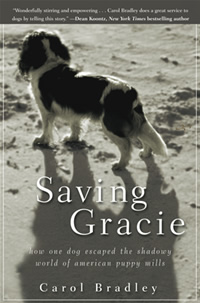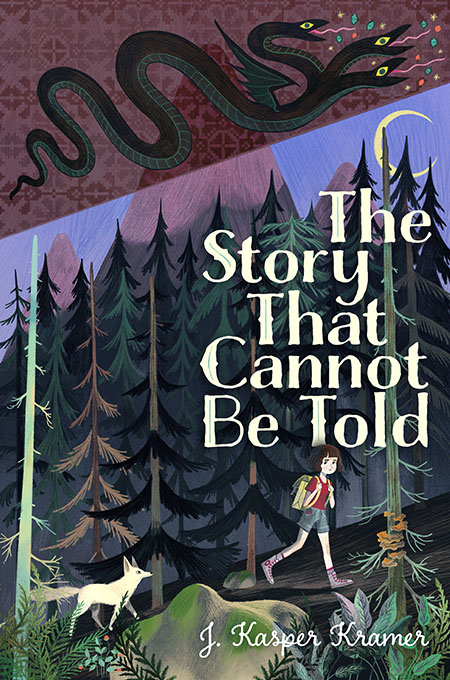Human Wrongs and Animal Rights
Carol Bradley tells the heartbreaking story of that doggie in the window
“All dogs matter.” This is the starting point for former Nashville Banner reporter Carol Bradley in her powerful new book about unscrupulous dog breeders, Saving Gracie. She calls puppy mills a “national disgrace” and exposes it as “one of America’s most shameful secrets.” Basing her story on a successful but highly abusive Pennsylvania breeder, Bradley describes in harrowing detail how dogs are abused for profit and how difficult it has been for law enforcement authorities to stop the practice.
Bradley, now living in Montana, first became aware of the existence of puppy mills in 2002 when an Alaskan couple was stopped at the Canadian border carrying 120 collies in cages stacked three high in the back of a tractor trailer. During the entire 2,240 mile journey the driver had not stopped a single time to give the animals food or water. The collies were rescued and temporary homes found for them, though legally they remained the property of the original abusive owners. After two trials over the course of nine months, the owners were finally convicted of animal cruelty, and the dogs were free to be adopted. This common pattern repeated itself in the Pennsylvania case which forms the center of Saving Gracie.
Carol Bradley answered questions from Chapter 16 prior to her appearance at McNeely Pigott & Fox in Nashville on May 13 at 5 p.m.
Chapter 16: Many readers will be unfamiliar with the term “puppy mill.” What distinguishes a puppy mill from a legitimate breeder?
 Bradley: Puppy mills are commercial kennels where dogs are treated like livestock and kept in cages 24/7. Puppy mills can contain as few as a dozen dogs or more than a thousand, and they are often squalid—exposing dogs to extreme temperatures, inadequate food and water, and little to no socialization or veterinary care. Breeding dogs in puppy mills sometimes languish for years with untreated skin, ear, and eye infections and badly mended broken legs because breeders don’t want to spend money on veterinary bills. They will never experience a toy, a blanket or a kind pat on the head, and once a breeding dog is unable to produce any more puppies, she is typically taken out and shot to death.
Bradley: Puppy mills are commercial kennels where dogs are treated like livestock and kept in cages 24/7. Puppy mills can contain as few as a dozen dogs or more than a thousand, and they are often squalid—exposing dogs to extreme temperatures, inadequate food and water, and little to no socialization or veterinary care. Breeding dogs in puppy mills sometimes languish for years with untreated skin, ear, and eye infections and badly mended broken legs because breeders don’t want to spend money on veterinary bills. They will never experience a toy, a blanket or a kind pat on the head, and once a breeding dog is unable to produce any more puppies, she is typically taken out and shot to death.
In contrast, good breeders stick to just one or two breeds; they keep their dogs in good physical health and devote time to socializing them. They’ll want to check you out before selling you a puppy and will be happy to show you where the puppy was raised. If you ever decide to give up the dog, a good breeder will insist you bring it back to them.
Chapter 16: Any idea how many puppy mills exist in the United States today?
Bradley: The Humane Society of the United States estimated in 2008 that there were 10,000 puppy mills in America. The head of the Humane Society, Wayne Pacelle, now thinks the number is closer to 15,000.
Chapter 16: What about Tennessee?
Bradley: Tennessee has ten dog breeders licensed by the federal government, but that’s a fraction of the real number, and some of these kennels are horrific. Since last fall alone, ninety dogs were taken from dark sheds and makeshift pens in Roane County; fifty inbred and emaciated dogs were seized from a breeder in Lawrence County; fifty dogs suffering parasites and infections were removed from a kennel in Dickson County; more than two dozen dogs caked with urine and feces were taken from a Maury County kennel; and last month 230 dogs suffering heart problems, eye infections, and birth defects were hauled out of a kennel in Sparta. One of the largest puppy-mill busts in the country occurred in 2008, when nearly 700 dogs crowded two and three to a hutch in unrelenting summer heat were rescued from a kennel in Lyles, Tennessee, southwest of Nashville.
Chapter 16: Are there any states where disreputable breeding practices are actually illegal? What laws exist to control them?
Bradley: Every state has laws prohibiting animal cruelty. The federal Animal Welfare Act provides minimal standards for licensed breeders, and a growing number of states are starting to license kennels and scrutinize them more carefully. The problem is that there aren’t nearly enough inspectors to do the job. The U.S. Department of Agriculture has just 100 inspectors responsible for keeping tabs on 10,000 kennels, zoos, and research labs. Tens of thousands of breeders operate off the radar. If they’re not licensed, no one is checking on them at all.
The good news is that more and more states are focusing attention on the problem. The state of Pennsylvania passed a ground-breaking puppy-mill law two years ago. Among other things, it doubled the floor space of dog cages, mandated exercise areas for dogs, requires that dogs receive veterinary care twice a year, and forbids breeders from killing dogs themselves. It’s not enough to pass a strict law, however; the key is how adequately it is enforced.
Chapter 16: You note that puppy mills surfaced when corporate interests displaced mom-and-pop breeders. Can you explain a little bit more about that?
 Bradley: Corporate franchises began to replace mom-and-pop pet stores after World War II. These new stores put ‘doggies in the window’ as a marketing ploy. They offered customers a variety of breeds and let them charge their purchases, which made it very easy to buy a dog on impulse. Between the 1940s and the mid-1970s, the number of purebred dogs registered in the United States jumped from 77,000 a year to a million. Someone needed to supply this huge new demand for dogs, and that’s when puppy mills began to emerge.
Bradley: Corporate franchises began to replace mom-and-pop pet stores after World War II. These new stores put ‘doggies in the window’ as a marketing ploy. They offered customers a variety of breeds and let them charge their purchases, which made it very easy to buy a dog on impulse. Between the 1940s and the mid-1970s, the number of purebred dogs registered in the United States jumped from 77,000 a year to a million. Someone needed to supply this huge new demand for dogs, and that’s when puppy mills began to emerge.
Chapter 16: You found the involvement of Amish communities to be particularly instructive cases. Can you elaborate?
Bradley: Culturally, Amish farmers have a hard time understanding why anyone would treat a dog as a member of the family. The Amish view dogs as livestock, and they have no problem keeping dogs in rabbit hutch-style cages inside a dark barn their entire lives, with little to no care. To them, dogs are expendable. With livestock comes deadstock, as the saying goes. But by no means do the Amish corner the market on irresponsible breeding.
Chapter 16: What positions, if any, has each political party taken on efforts to strengthen anti-abuse laws?
Bradley: The biggest political group fighting the curtailment of puppy mills is the agriculture industry, which views dog-breeding much the way it does other forms of animal husbandry—as something that’s really none of the government’s business.
Chapter 16: Is it ever safe to buy a dog from a pet store?
Bradley: Not in my opinion. Puppies sold in pet stores almost always come from puppy mills. They often go home with their new owner sick and completely unsocialized. It’s not uncommon for a pet-store dog to die days or weeks after a family has spent hundreds, if not thousands, of dollars in veterinary bills. There are plenty of better places to get your next pet.
Chapter 16: Saving Gracie is a powerful indictment of the breeding industry. What can ordinary people do to stop these abuses?
Bradley: Never, ever buy a dog at a pet store. In fact, don’t buy anything from a store that sells dogs and cats. Be extremely wary of websites that sell dogs: they are full of false assurances that the dogs they’re selling have been treated like members of the family. Far too often, the truth is much harsher. If you suspect a breeder of treating dogs badly, report him or her to your local humane society. Encourage your state legislature to clamp down on shoddy breeding practices. And consider adopting your next dog from a shelter or a rescue group. These dogs are often healthy and smart; they make wonderful companions, and, best of all, they’re practically free.
Carol Bradley will read from her book on May 13 at 5 p.m. in the offices of McNeely Piggott & Fox (611 Commerce St., Suite 2800) in Nashville. RSVP to bookevent@mpf.com or call (615) 259-4000, ext. 200. She will also appear May 15 at Carpe Librum Booksellers (5113A Kingston Pike) in Knoxville at 4 p.m. Both events are free and open to the public.





